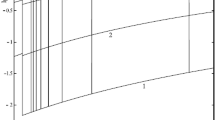Abstract
The contraction of a massive rotating plasma cloud with the magnetic field perpendicular to the axis of rotation and extending to infinity is considered. At some stage the contracting cloud reaches a state of dynamic quasi-stationary equilibrium. The change of the magnetic field in the cloud atmosphere before its arrival at the quasi-stationary state (stage I) and also in the process of quasi-equilibrium (stage II) are studied.
At stage I an essential change of the external magnetic field geometry occurs, namely the formation of zero (neutral) lines and the transformation of the field into a quasi-radial one. Given certain conditions, the reconnection of the field lines in neutral X-type points may occur with the formation of closed loops. In this case the flux of field lines, which connect the contracting cloud with infinity, decreases asymptotically as (R/R i)2/3, whereR/R i is the ratio of the present radius to initial one.
After the cloud arrives at the state of dynamic equilibrium (stage II) a considerable increasing of the magnetic field occurs due to twisting of the field lines by rotation. The field strength increases up to some threshold after which instability suddenly occurs. As a result of cumulation occurring in the zero-line direction, and the subsequent dynamic dissipation, the ejection of relativistic particles and plasma in both directions along the rotational axis takes place. The magnetic field restores itself rapidly due to the continual twisting and this leads to the appearance of repeated explosions.
The tension of the magnetic field lines as well as plasma outflow carry away the angular momentum. Its diminution determines the rate of secular gravitational contraction. During the contraction the rotational energy increases, so that recurrent bursts, being of magneto-rotational nature are based, finally, on the gravitational energy reservoir.
According to our calculations of the time-interval for repetition of explosions, the energy output and certain other parameters, we are able to explain repeated bursts in the nuclei of galaxies and quasars observed, in particular, in the appearance of radio-variability.
Similar content being viewed by others
References
Cavaliere, A., Pacini, F., and Setti, G.: 1969,Astrophys. Letters 4, 103.
Ginzburg, V. L. and Ozernoy, L. M.: 1964,Soviet Phys.-JETP 20, 689.
Greenstein, J. L. and Schmidt, M.: 1964,Astrophys. J. 140, 1.
Hamberger, S. M. and Friedman, M.: 1968,Phys. Rev. Letters 21, 674.
Hoyle, F.: 1960,Quart. J. Roy. Astron. Soc. 1, 28.
Kellermann, K. I. and Pauliny-Toth, I. I. K.: 1968,Ann. Rev. Astron. Astrophys. 6, 417.
Mestel, L.: 1966,Monthly Notices Roy. Astron. Soc. 133, 265.
Mestel, L. and Spitzer, L.: 1956,Monthly Notices Roy. Astron. Soc. 116, 503.
Morrison, P.: 1969,Astrophys. J. Letters 157, L73.
Ozernoy, L. M.: 1966,Soviet Astron.-AJ 10, 241.
Ozernoy, L. M.: 1968a, ‘Problems of Stellar Evolution and Variable Stars’, in Proc. Sympos. held on 24–27 November, 1964, Izd. Nauka, Moscow, p. 140ft.
Ozernoy, L. M.: 1968b, inProc. All-Soviet Winter School on Cosmic Physics (Apatityi), p. 48ft.
Ozernoy, L. M. and Usov, V. V.: 1970,Astrophys. Space Sci. (in press).
Ozernoy, L. M. and Chertopud, V. E.: 1967,Astron. Zh. 44, 537.
Petschek, H. E.: 1963, in ‘Physics of Solar Flares’ (AAS-NASA Symposium), p. 425ft.
Piddington, J. H.: 1966,Monthly Notices Roy. Astron. Soc. 133, 163.
Piddington, J. H.: 1970,Monthly Notices Roy. Astron. Soc. 148, 131.
Schatzman, E.: 1959, inIAU Sympos. 10 (ed. by J. L. Greenstein), Paris, p. 129ft.
Shklovsky, I. S.: 1965,Astron. Zh. 42, 893.
Shklovsky, I. S.: 1970,Astron. Zh. 47, 742.
Sturrock, P. A.: 1966,Nature 211, 697.
Sturrock, P. A.: 1969, inPlasma Instabilities in Astrophysics, Gordon and Breach, New York, p. 297ft.
Syrovatskii, S. I.: 1966,Soviet Astron.-AJ. 10, 270;Soviet Phys.-JETP 23, 755.
Sweet, P. A.: 1958,Nuovo Cimento Suppl. 8 (serie 10), 188.
Takarada, K.: 1970,Progress Theoret. Phys. 43, 2.
Woltjer, L.: 1970,Columbia Univ. Astrophys. Lab. Contrib. No. 24.
Author information
Authors and Affiliations
Additional information
Extended version of the paper read at All-Moscow Astrophysical Seminar in Sternberg Astronomical Institute 3rd April 1969.
Rights and permissions
About this article
Cite this article
Ozernoy, L.M., Somov, B.V. The magnetic field of a rotating cloud and magneto-rotational explosions. Astrophys Space Sci 11, 264–283 (1971). https://doi.org/10.1007/BF00661358
Received:
Issue Date:
DOI: https://doi.org/10.1007/BF00661358



